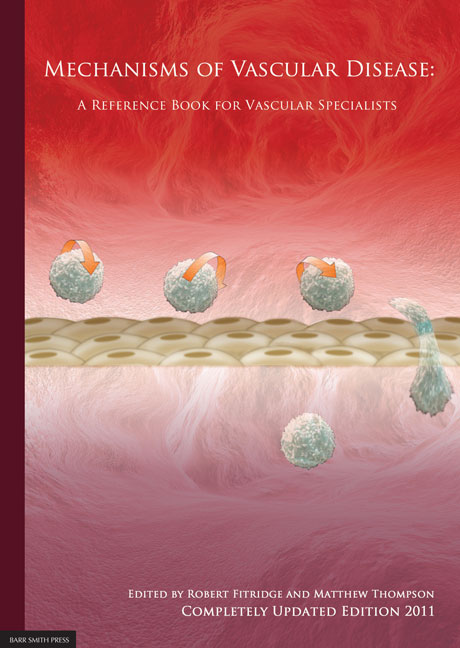Book contents
- Frontmatter
- Contents
- List of Contributors
- Detailed Contents
- Acknowledgements
- Abbreviation List
- 1 Endothelium
- 2 Vascular smooth muscle structure and function
- 3 Atherosclerosis
- 4 Mechanisms of plaque rupture
- 5 Current and emerging therapies in atheroprotection
- 6 Molecular approaches to revascularisation in peripheral vascular disease
- 7 Biology of restenosis and targets for intervention
- 8 Vascular arterial haemodynamics
- 9 Physiological Haemostasis
- 10 Hypercoagulable States
- 11 Platelets in the pathogenesis of vascular disease and their role as a therapeutic target
- 12 Pathogenesis of aortic aneurysms
- 13 Pharmacological treatment of aneurysms
- 14 Pathophysiology of Aortic dissection and connective tissue disorders
- 15 Biomarkers in vascular disease
- 16 Pathophysiology and principles of management of vasculitis and Raynaud's phenomenon
- 17 SIRS, sepsis and multiorgan failure
- 18 Pathophysiology of reperfusion injury
- 19 Compartment syndromes
- 20 Pathophysiology of pain
- 21 Post-amputation pain
- 22 Treatment of neuropathic pain
- 23 Principles of wound healing
- 24 Pathophysiology and principles of varicose veins
- 25 Chronic venous insufficiency and leg ulceration: Principles and vascular biology
- 26 Pathophysiology and principles of management of the diabetic foot
- 27 Lymphoedema – Principles, genetics and pathophysiology
- 28 Graft materials past and future
- 29 Pathophysiology of vascular graft infections
- Index
22 - Treatment of neuropathic pain
Published online by Cambridge University Press: 05 June 2012
- Frontmatter
- Contents
- List of Contributors
- Detailed Contents
- Acknowledgements
- Abbreviation List
- 1 Endothelium
- 2 Vascular smooth muscle structure and function
- 3 Atherosclerosis
- 4 Mechanisms of plaque rupture
- 5 Current and emerging therapies in atheroprotection
- 6 Molecular approaches to revascularisation in peripheral vascular disease
- 7 Biology of restenosis and targets for intervention
- 8 Vascular arterial haemodynamics
- 9 Physiological Haemostasis
- 10 Hypercoagulable States
- 11 Platelets in the pathogenesis of vascular disease and their role as a therapeutic target
- 12 Pathogenesis of aortic aneurysms
- 13 Pharmacological treatment of aneurysms
- 14 Pathophysiology of Aortic dissection and connective tissue disorders
- 15 Biomarkers in vascular disease
- 16 Pathophysiology and principles of management of vasculitis and Raynaud's phenomenon
- 17 SIRS, sepsis and multiorgan failure
- 18 Pathophysiology of reperfusion injury
- 19 Compartment syndromes
- 20 Pathophysiology of pain
- 21 Post-amputation pain
- 22 Treatment of neuropathic pain
- 23 Principles of wound healing
- 24 Pathophysiology and principles of varicose veins
- 25 Chronic venous insufficiency and leg ulceration: Principles and vascular biology
- 26 Pathophysiology and principles of management of the diabetic foot
- 27 Lymphoedema – Principles, genetics and pathophysiology
- 28 Graft materials past and future
- 29 Pathophysiology of vascular graft infections
- Index
Summary
INTRODUCTION
Neuropathic pain is defined by The International Association for the Study of pain (IASP) as pain following a primary lesion or dysfunction of the nervous system. It is caused either by peripheral damage with lesions involving peripheral nerves, dorsal root ganglia and the dorsal roots (peripheral neuropathic pain) or by central damage, which may involve injury caused by infarction or trauma of spinal cord or brain (central neuropathic pain).
Neuropathic pain results in persistent pain syndromes that have no biological function, but are difficult to treat and cause great distress to the individual. Neuropathic pain is also referred to as neurogenic pain, deafferentation pain, neuralgia, neuralgic pain and nerve pain.
Neuropathic pain may develop immediately after a nerve injury or after a variable interval. It may be maintained by factors different from the initial cause. It can persist for a long time and is frequently not explained by underlying pathology. Patients are frequently seen by many different specialists and their treatment often fails to resolve the pain. As the pain persists other factors such as environmental, psychological and social stressors become relevant contributors to the overall presentation.
PRINCIPLES OF TREATMENT
Treatment of neuropathic pain is not straightforward. The pain is often refractory to conventional analgesic regimens such as Non-Steroidal Anti-Inflammatory Drugs (NSAIDs). Opioids have only limited efficacy in neuropathic pain as outlined later in this chapter; therefore so called co-analgesics, medications which are not typically used as analgesics, are often the first-line treatment of neuropathic pain.
- Type
- Chapter
- Information
- Mechanisms of Vascular DiseaseA Reference Book for Vascular Specialists, pp. 401 - 422Publisher: The University of Adelaide PressPrint publication year: 2011

